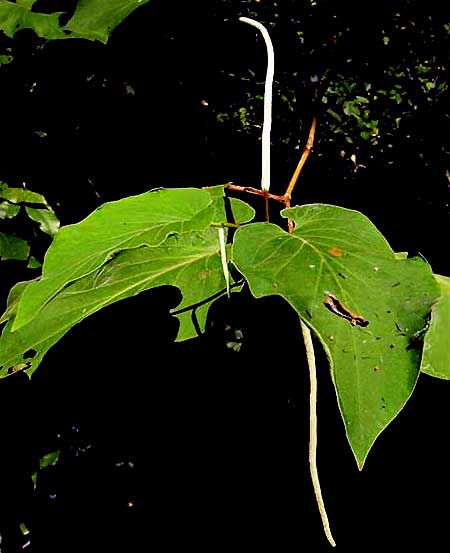

This small tree, native to Mexico but requiring more rain than falls in the northern Yucatan, often is planted around houses here. The words Hoja Santa mean, more or less, Blessed Leaf, because the tree's fresh leaves when crushed fill the air with a delightful odor, one that reminds some of anise, but which I always think of as the odor of root beer. Hoja Santa's foot-long (30cm) leaves are soft and have rounded ears at their bases, and its tiny white flowers are grouped in long, slender spikes.
You probably know that the Mexican tamale is about the size of a package of cigarettes and is made of a pillow-shaped, moist lump of cornmeal, or masa, inside which can be almost any ingredient, such as beans. The tamale must be steamed before it is eaten. While being steamed, the tamale must be wrapped in something to keep it from coming apart. Traditionally the tamale wrapper is cornhusks, but if you want a particularly flavorful tamale, maybe for a fiesta, you use Hoja Santa leaves. Steam causes the leaves' cells to break down, releasing their fragrant and tasty oils into the masa.
Hoja Santa, Piper auritum, is a member of the Black Pepper Family and belongs to the same genus as the southern Indian vine from which the pepper of salt-and-pepper fame comes. When the ovaries of Hoja Santa's tiny flowers' mature, the resulting fruits are genuine peppercorns, but they're too small to be worth drying and grinding into black pepper.
Something else interesting about Hoja Santa -- and you can confirm this in our picture -- is that when its small, greenish spikes of immature flowers first emerge they hang down. As the spikes enlarge and the flowers become ready to be pollinated by visiting insects, the spikes turn vividly white and are held erect. After pollination, when the flowers no longer need to be visited by insects, the spikes once again turn downward.
By moving its spikes up and down like this, and making the spike brightly white when its flowers need pollination, Hoja Santa is communicating with its pollinators. It's telling its pollinators to pay attention to conspicuous flowers on the upright spikes needing to be pollinated, but not to bother visiting the less noticeable flowers on the down-hanging spikes, which are either too young or too old for pollination.